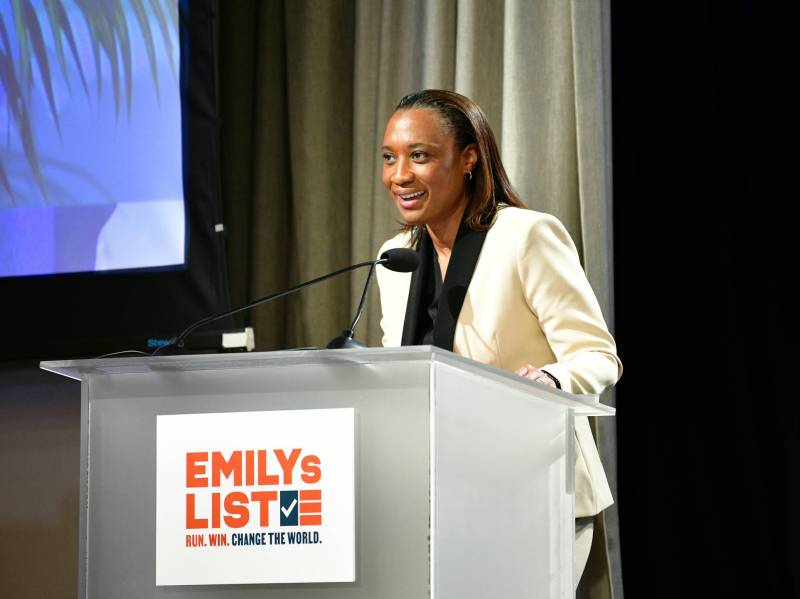Butler is a Democratic powerhouse with progressive credentials who worked for years at the labor union SEIU. She also advised Hillary Clinton’s 2016 presidential campaign and for a time was a partner at Bearstar Strategies, Newsom’s top political consulting firm. Still, it could be tough to mount a senate campaign with just five months left before the primary election.
Trauma in Childhood
Butler was born in Magnolia, Miss., the youngest of three children. Her father battled heart disease and died when she was a teenager. Butler told KQED’s Political Breakdown that her mother worked multiple jobs to keep the family afloat, in addition to caring for her father.
“My life was really lived through the eyes of a caregiver,” Butler said. “My mother was my father’s caregiver in the last years of his life, and having to understand what families everyday go through when it comes to issues like health care…really was the precursor to my professional career.”
That career took off in California. She arrived in the state in 2009, working as an organizer for long-term care workers with SEIU.
Labor Leadership
Butler quickly rose to leadership of the caregivers union and in 2013 was elected head of SEIU California, the state’s largest union, representing more than 700,000 workers.
In that position Butler led SEIU’s push to raise California’s minimum wage to $15 an hour, the result of high-stakes negotiations between Butler and Gov. Jerry Brown’s chief of staff Nancy McFadden.
“We were both working for the people of California,” Butler remembered in the Political Breakdown interview. “She represented way more than I did. But we all came into rooms of tension and disagreement and negotiation with Californians in mind and the best for Californians.”
Newsom’s choice of Butler earned the praise of Aimee Allison, who is a vocal ally of Congresswoman Lee. Allison, founder of She the People – which helps elect women of color to office – had lobbied the governor to appoint Lee, and said Newsom kept his promise by tapping Butler.
“I know Laphonza Butler, and her long history of commitments to working people, women, and the gay community, and her work behind the scenes to elect the Vice President. She is a well-respected leader here in California and understands our diverse, growing electorate and will do admirably in the Senate,” Allison said.
Butler, who moved her family from Los Angeles to work in Washington, D.C., when she took over as EMILY’s List president in 2021, is currently registered in Maryland. Newsom’s office said she will re-register in California, where she still owns a home, before she is sworn in.
Sen. Alex Padilla said he’s “honored to welcome” Butler to the Senate, noting her longtime work for “working families, LGBTQ rights, and a champion for increasing women’s representation in politics.”
“Gov. Newsom’s swift action ensures that Californians maintain full representation in the Senate as we navigate a narrow Democratic majority. I look forward to working together to deliver for the people of California.”
What this means for California voters
With Newsom’s decision now out of the way, the next decider of that Senate seat will be California voters.
In March 2024, voters will have two choices to make: who will compete to fill out the remainder of Feinstein’s term and who will compete to fill the full term beginning in January 2025.
Essentially, California voters will simultaneously vote in two primaries on the March ballot and then in two general elections on the November ballot.
The candidate that wins the November election to fulfill the remainder of Feinstein’s term will only serve for about two months. The candidate that wins the full term will be sworn in Jan. 3, 2025.
If this feels somewhat familiar, it’s because a less complicated version of it happened in 2022. Sen. Alex Padilla was appointed by Newsom in December 2020 after then-Sen. Kamala Harris won Vice President, four years into her six-year senate term. Last November, Padilla ran to complete the last two months of that term and run for the next term that began in January 2023.
Kim Alexander, president of the California Voter Foundation, said the election process might be confusing to voters, but it prevents a gubernatorial appointment from serving for multiple years without a vote from the people.
“It protects voters’ ability to have a say in who represents them in the Senate, whether it’s for two months or for four or five years,” Alexander said.


